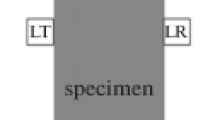Abstract
In this work, the damage progression of concrete cracks presented in concentrated form caused by mechanical load and presented in distributed form caused by chemical attack is characterized by a harmonic wave modulation technique. The relative amplitude of sidebands in frequency domain due to the modulation effect of two propagating ultrasonic waves is considered as the damage index for concrete samples. The low frequency signal in this research is a harmonic wave produced by an electromagnetic exciter to avoid the uncertainty of man-made influence previously where the low frequency pulse signal was generated by the instrumented hammer. Both the first order sideband corresponding to classical nonlinearity effect and the second order sideband corresponding to hysteresis nonlinearity effect are simultaneously analyzed through the ultrasonic experiments for damaged samples induced by the sulfate attack and bending tests. The nonlinear parameters present a good distinction between damaged and intact samples for both concentrated cracks and distributed cracks and have an increase in orders of magnitude, showing the well-round feasibility of developed nonlinear wave modulation technique. Furthermore, the nonlinear parameters in the wave modulation technique present an excellent correlation with the nonlinear parameter obtained by the second harmonic generation method for bending cracks of the same reinforced concrete, indicating that the wave modulation method is capable of discriminating different state of damage presented in concentrated cracking form.















Similar content being viewed by others
References
Aggelis DG (2013) Wave propagation through engineering materials; assessment and monitoring of structures through non-destructive techniques. Mater Struct 46:519–532
Ohtsu M (2011) Damage evaluation in freezing and thawing test of concrete by elastic-wave methods. Mater Struct 44:1725–1734
Zhou C, Li K, Han J (2012) Characterizing the effect of compressive damage on transport properties of cracked concretes. Mater Struct 45:381–392
Shiotani T, Aggelis DG (2009) Wave propagation in cementitious material containing artificial distributed damage. Mater Struct 42:377–384
Popovics S, Rose JL, Popovics JS (1990) The behavior of ultrasonic pulses in concrete. Cem Concr Res 20:259–270
Yim HJ, Kwak H-G, Kim JH (2012) Wave attenuation measurement technique for nondestructive evaluation of concrete. Nondestruct Test Eval 27:81–94
Van Hauwaert A, Thimus J-F, Delannay F (1998) Use of ultrasonics to follow crack growth. Ultrasonics 36:209–217
Guyer A, Johnson PA (1999) Nonlinear mesoscopic elasticity: evidence for a new class of materials. Phys Today 52:30–35
Pier Paolo Delsanto (2006) University of nonclassical nonlinearity: application to nondestructive evaluations and ultrasonics. Springer, New York
Lesnicki KL, Kim J-Y, Kurtis KE, Jacobs LJ (2013) Assessment of alkali–silica reaction damage through quantification of concrete nonlinearity. Mater Struct 46:497–509
Chen J, Zhang L (2015) Experimental study of effects of water-cement ratio and curing time on nonlinear resonance of concrete. Mater Struct 48:423–433
Chen J, Xu Z, Yu Y, Yao YP (2014) Experimental characterization of granite damage using nonlinear ultrasonic techniques. NDT&E Int 67:10–16
Kim J-Y, Jacobs LJ, Qu J, Littles JW (2006) Experimental characterization of fatigue damage in a nickel-base superalloy using nonlinear ultrasonic waves. J Acoust Soc Am 120:1266–1273
Shui GS, Wang YS, Huang P, Qu JM (2015) Nonlinear ultrasonic evaluation of the fatigue damage of adhesive joints. NDT&E Int 70:9–15
Shah AA, Ribakov Y, Zhang Ch (2013) Efficiency and sensitivity of linear and non-linear ultrasonics to identifying micro and macro-scale defects in concrete. Mater Des 50:906–916
Liu Y, Chillara VK, Lissenden CJ, Rose JL (2013) On selection of primary modes for generation of strong internally resonant second harmonics in plate. J Sound Vib 332:4517–4528
Donskoy D, Sutin AM, Ekimov A (2001) Nonlinear acoustic interaction on contact interfaces and its use for nondestructive testing. NDT&E Int 34:231–238
Ekimov AE, Didenkulov ID, Kazakov VV (1997) Modulation of torsional waves in a rod with a crack. J Acoust Soc Am 106:1289–1292
Chen J, Jayapalan AJ, Kurtis KE, Kim JY, Jacobs LJ (2009) Nonlinear wave modulation spectroscopy method for ultra-accelerated ASR assessment. ACI Mater J 106:340–348
Warnemuende K, Wu HC (2004) Actively modulated acoustic nondestructive evaluation of concrete. Cem Concr Res 34:563–570
Landau LD, Lifshitz EM (1986) Theory of elasticity, 3rd edn. Butterworth-Heinemann, Oxford
Guyer RA, Johnson PA (2009) Nonlinear mesoscopic elasticity. The complex behavior of granular media including rock and soil. WILEY-VCH Verlag GmbH & Co. KGaA, Weinheim
Van Den Abeele KE-A, Johnson PA, Sutin AM (2000) Nonlinear elastic wave spectroscopy (NEWS) techniques to discern material damage, part I: nonlinear wave modulation spectroscopy (NWMS). Res Nondestruct Eval 12:17–30
Chinese Concrete Standard (2007) Design standard for concrete structures (GB50010-2010). Chinese Standard Publishing, Beijing
Standard European (2011) Cement. Composition, specifications and conformity criteria for common cements (BS EN 197-1:2011). European Committee for Standardization, Brussels
Payan C, Garnier V, Moysan J (2010) Effect of water saturation of porosity on the nonlinear elastic response of concrete. Cem Concr Res 40:473–476
Acknowledgements
The authors gratefully acknowledge the support from National Natural Science Foundation of China (Grant Nos. 51308020, 51578032), Major Fundamental Research of China (973 Program, Grant No. 2014CB047003) and Beijing Natural Science Foundation (Grant No. 8162027). The effort made by Mr. Wanli Meng in a part of the experimental work is appreciated.
Author information
Authors and Affiliations
Corresponding author
Ethics declarations
Conflict of interest
The authors declare that they have no conflict of interest.
Rights and permissions
About this article
Cite this article
Chen, J., Wu, Y., Yin, T. et al. Characterization of concentrated and distributed cracks in concrete using a harmonic wave modulation technique. Mater Struct 51, 1 (2018). https://doi.org/10.1617/s11527-017-1129-0
Received:
Accepted:
Published:
DOI: https://doi.org/10.1617/s11527-017-1129-0




